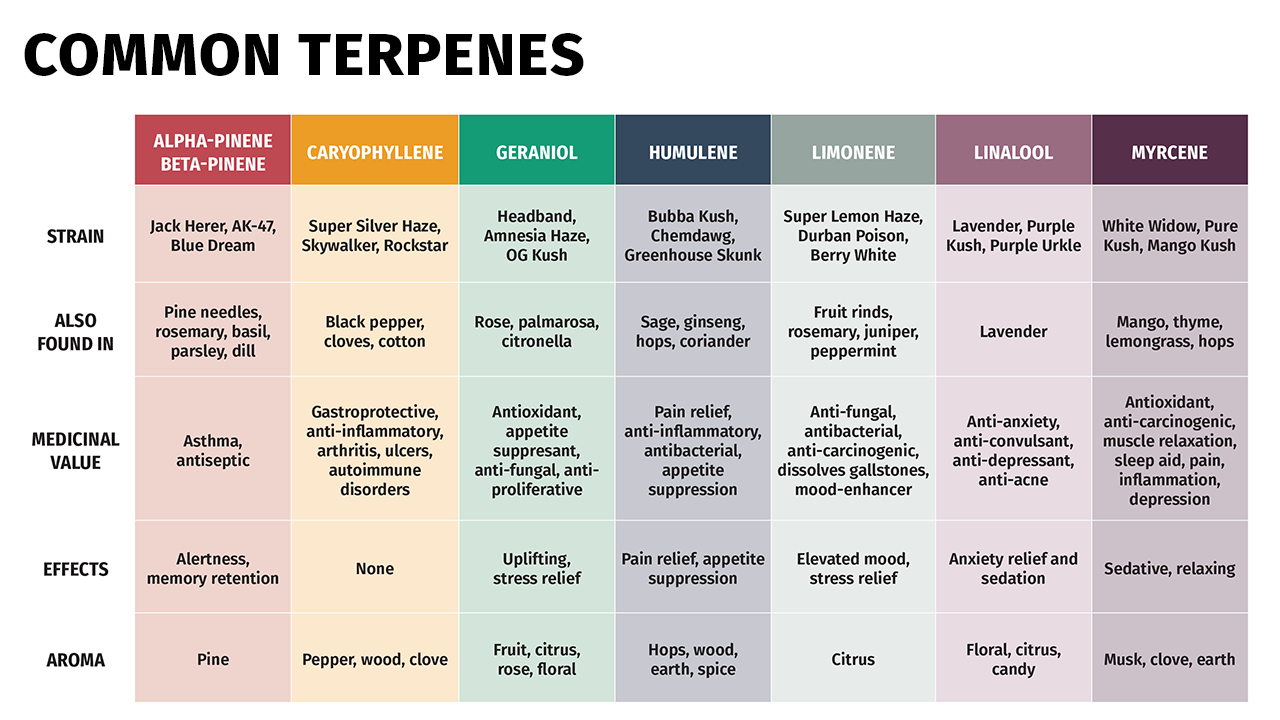Better Understanding Terpenes
Lucid Green is committed to trust and transparency in cannabis. Consumer education of cannabis with regards to what is exactly in the cannabis one consumes goes a long way in creating an optimal cannabis experience for all. As we emphasized in our past article, “an educated consumer is our best customer,” Lucid Green aims to provide cannabis consumers detailed information regarding the cannabis they consume. This is accomplished via LucidIDs, the intelligent UPC (universal product code) of cannabis which is found on cannabis packages. But consumers also need to understand what the active ingredients in cannabis are and their potential effects.
Our previous article explained a better understanding of cannabinoids. Here we tackle “Better Understanding Terpenes.”
Terpenes are natural chemical compounds that are present in many different plants. Terpenes express themselves in aromas, flavors, and colors of various plants. As they relate to cannabis, terpenes affect how different strains taste and smell. Terpenes may also have different medicinal-like properties.
Terpenes are nature’s way of protecting plants from harsh weather and predators. Terpenes help to enhance the plant’s attractiveness to some creatures, while deterring others that can do harm. Regarding effects on humans, there has been some initial research, but there is still much experimentation and investigation to be done to classify cannabis products. It is believed that terpenes work as an “entourage effect” with tetrahydrocannabinol (THC), cannabidiol (CBD), and other cannabinoids — to produce the different effects.
It is not believed that terpenes make people feel high, but some people believe they are psychoactive, because they do have effects on the brain. Others believe that terpenes impact the effects of THC, the cannabinoid responsible for the high feeling from cannabis. Thus, many cannabis connoisseurs state there is too much emphasis on THC levels when more attention and interest should be paid on terpene profiles to optimize one’s cannabis experiences. It is believed that terpenes have potential benefits as it relates to certain mental health issues.
Cannabis contains more than 150 types of terpenes. Below is a brief primer to the predominant terpenes found in cannabis:
(Source: https://mjbizdaily.com/manufacturers-split-on-value-of-marijuana-terpene-labels/)
Initial research indicates that terpenes may be beneficial for the following conditions.
Antiviral - Many terpenes show strong abilities to help kill viruses, including alpha- and beta-pinene, caryophyllene, camphor, and carvone.
Anticancer - Some terpenes, including those found in cannabis, exhibit anticancer activity, helping to inhibit the activity or growth of cancer cells.
Antidepressant - Given the mood-altering properties of many terpenes, it’s no surprise that these potent compounds may also offer antidepressant activity. Twenty-five percent of antidepressant drugs are formulated using herbal extracts that contain terpenes.
Antimicrobial - A vast array of terpenes display antimicrobial activity, or the ability to halt a harmful microorganism in its tracks. Terpenes that are particularly effective in killing or stopping the progression of microorganisms include alpha-bisabolol, geraniol, menthol, eucalyptol, and terpinolene.
Pain relief - Researchers have found that some cannabis terpenes mimic cannabinoids by creating an analgesic effect, or a reduction in pain.
(Source - https://www.leafly.com/news/cannabis-101/terpenes-the-flavors-of-cannabis-aromatherapy)
As with cannabinoids, there is still much research to be done on the different terpenes within cannabis. While some information is available, we encourage you to continue to seek out additional information as it becomes available.
Lucid Green is committed to trust and transparency in the cannabis industry. We look to help brands provide all important information for their consumers. This is delivered via LucidIDs. Cannabis brands can provide a plethora of useful information to their consumers when they include LucidIDs on their packaging. Any user who scans a LucidID on-pack is presented with a rich product experience. Scanning provides consumers with recommended dosage, effects, ingredients, lab results, links to website/video…and more. As deeper research is conducted and there is more information available on the effects of various cannabinoids, each individual’s cannabis experience will be richer and more rewarding.
Schedule a demo here.
Sources:
https://mjbizdaily.com/manufacturers-split-on-value-of-marijuana-terpene-labels/
https://www.leafly.com/news/cannabis-101/list-major-cannabinoids-cannabis-effects
https://tanasi.com/blog/cbg-vs-cbga-definitions-benefits-and-products/
https://en.wikipedia.org/wiki/Tetrahydrocannabinol
https://www.health.harvard.edu/blog/cannabidiol-cbd-what-we-know-and-what-we-dont-2018082414476
https://www.healthline.com/nutrition/cbd-oil-benefits#TOC_TITLE_HDR_1
https://en.wikipedia.org/wiki/Cannabichromene
https://www.cibdol.com/cbd-encyclopedia/discover-the-cannabinoid-acid-cbca
https://www.newphaseblends.com/cbgv-cannabigerovarin/
https://jcannabisresearch.biomedcentral.com/articles/10.1186/s42238-020-0016-7
https://www.leafly.com/news/cbd/what-is-cbdv-cannabidivarin-marijuana-cannabinoid
https://www.leafly.com/news/cannabis-101/what-is-cannabichromene-cbc-cannabinoid
https://www.leafly.com/news/science-tech/meet-bliss-molecule-anandamide-cannabinoid

